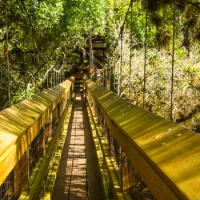Fish On!
Sarasota-area waters offer an abundance of angling delights
The captain spotted the school of tarpon swimming parallel to the beach, 100 yards from shore.
"Wait until I give the signal to cast," he told the angler. "You may only get one chance."
The large, thick-bodied fish, often referred to as "the silver king of game fish," run south along local beaches every spring. But for some reason, the tarpon linger a little longer in the shallow waters off this barrier island.
It could be because of the large amount of bait that is flushed out of Tampa Bay and carried with the prevailing current south.
Then again, tarpon, like the hundreds of thousands of visitors who come to Sarasota every year, might just like it here.
It isn't unusual to see charter boats lined up, single file, when the tarpon are running along local beaches. Each angler might only get one cast, but that is all they need.
A tarpon, hooked on light tackle, can take as long as an hour to bring in. Those who fight one of these fish, win or lose, always remember the battle as if it happened only yesterday.
"There is nothing like it," says one fisherman, who fishes the waters off Longboat Key every chance he gets. "Pound for pound, there is no better fighting fish."
The Florida state record for tarpon is 243 pounds, but fish weighing more than 200 pounds is a rarity. Still, anglers regularly catch fish in the 50- to 150-pound range.
Megalops atlanticus isn't the only species sportsmen will encounter off the Sarasota coast. Twice a year, in the spring and fall, king mackerel make the run to and from their feeding grounds off the Florida Panhandle.
Kingfish, as they are commonly called, can pull a line off a reel so fast, they will actually make the gears smoke. These big "smokers" can weigh 50 pounds or more. Conservation measures in recent years have increased their stock, which has led to a vibrant professional kingfish tour up and down the Gulf Coast.
Where you will find kingfish, you will also find Spanish mackerel. "Macks," as they are sometimes called by local anglers, are a thrill on light tackle. These lean, mean eating machines travel in schools, and when the bite is on, it is not uncommon for an angler to catch 20 or more in a day.
Once you have exhausted your opportunities with these two near-shore species, the big decision is whether to head offshore for the deepwater sportfish – grouper and snapper – or head into the protected backcountry of Sarasota Bay for a little light-tackle flats fishing.
The wrecks, artificial reefs and naturally occurring limestone outcroppings anglers call "hardbottom," are home to myriad bottom feeders including red, gag and black grouper, and red and mangrove snapper.
Anglers will also find big schools of gear-busting amberjack hovering above the wrecks, as well as cobia and the occasional sailfish.
It's possible, if the weather is good, to fish offshore in the morning then catch an incoming tide and fish the sea grass meadows, or "grass flats" in the afternoon.
Sarasota Bay has some of the best red drum fishing on the west coast of Florida. Fly rodders love to "sight'' cast to these bruisers as they root around the grass beds in search of shrimp and crab. Anglers look for "tailing" reds (so called because at low tide, about an inch of tail is visible above the water), then fire a fly or top-water plug in the fish's path and hold on.
Another highly prized inshore species is the common snook. This fish, often called a "linesider" because of the distinctive lateral marking that runs down the side of its body, is considered one of the best saltwater fighting fish in Florida waters.
Spotted sea trout, which along with snook and redfish make up the inshore slam, are another species that can be found patrolling the grass beds of the Intracoastal Waterway. Sea trout will hit about anything, which makes them a favorite target of novice anglers.

![Boat parking at The Crow’s Nest in Venice [Photo: Lauren Jackson]](/sites/default/files/styles/popular_stories_teaser/public/2023-import/The-Crow%2527s-Nest-cropped__OPT.jpg.webp?itok=ycs37M-O)



